| |

| <Latest Awards Topics> |
| Terminal
Report of the production of “School Among Glaciers” |
Dorji Wangchuk,Producer,Bhutan Broadcasting
Service(BBS) |
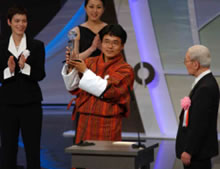 •Introduction •Introduction
On 5th November 2003, the Japan Prize International Educational
Program Contest conferred the Hoso Bunka Foundation (HBF)
award for the best proposal to the Bhutan Broadcasting Service
for “School Among Glaciers”. While it was historic
achievement for BBS to receive the first international award,
it was also historic event for Japan Prize as it was celebrating
the 30th anniversary and in fact instituted this award to
commemorate the event. The proposal then realised into a film
which was telecast over the BBS channel and had received wide
response for its excellence in quality and content. The film
has also been entered and nominated in two international film
festivals – Amsterdam and Basel. BBS plans to enter
the film in various festivals around the world in 2005.
This report provides some backstage information with the production
of this film. |
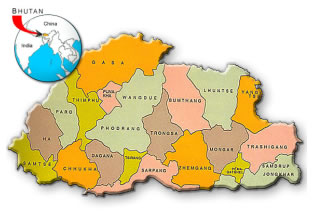 •Return
to Bhutan •Return
to Bhutan
In mid November, I returned to Bhutan with the trophy and
was accorded a hero welcome by my friends and relatives. I
was given a warm welcome back in the BBS where a small official
function was organised for me to formally hand over the trophy
to the Managing Director of BBS. And for all my colleagues
to congratulate me for the prize. It was the very first time
such an event took place in BBS. Several personal receptions
and dinner followed including one organised by the engineering
department where I had worked for 17 years before moving into
production.
Above all I received by the prime minister who congratulated
me on the award and wished more success in future.
Thanks to satellite programming on NHK World, the BBS radio
and TV carried the news the very next day I was awarded the
trophy in Tokyo. So after my return the national newspaper
Kuensel carried the news (clippings attached). |
•Pre-production
& planning (Dec. 2004 – April 2005)
Thanks to Hoso Bunka Foundation and the coverage accorded
by NHK World, BBS and Kuensel, soon the whole country came
to know about the prize including the international aid agencies
like UNICEF, WFP, WWF and private companies in Bhutan. I was
asked by several people that if I required anything for the
production, they would be very happy to a part of the production.
So it was then that I thought of enlarging the production
– from a 30 minute documentary to a feature length documentary
film. I rewrote the script, prepared the budget and I approached
the agencies for financial assistance to add up to the prize
money provided by HBF. With the trophy in hand it was not
very difficult to raise funds for the film and soon I raised
the additional $15,000 I required. UNICEF provided $ 4,000,
WFP provided $ 5,000 and Sustainable Development $ 6,000.
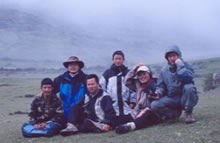 Many
private companies also sent contribution in kinds. Bhutan
Polymers sent 200 pieces of sacks for transportation, Army
Welfare Project contributed 24 bottles of whisky to beat the
cold of Lunana, Karma Steel sent five steel boxes for transporting
production gear and Lotus adventures rented us tents and camping
equipment free-of-charge.
Some other agencies provided logistic support. The Royal Bhutan
Army committed sending helicopters for emergency evacuation,
Gasa Dzongkhag Administration arranged the transportation
(horses and yaks) and the Department of Medical Services arranged
first aid kit for the production team.
The period from December to January passed as we raised funds
for the production. Besides that we carried out physical training
like trekking and walking in high mountains. The trek to Lunana
is considered the most difficult trek in the world and thus
required a heavy training and high level of fitness to carry
out an assignment there.
Spring came in March and with that two Deutsche Welle TV training
staff came over to train the production team in professional
works like camera, sound and lighting and non-professional
training in high-altitude survival, logistic planning and
production. In April we identified the teacher Mr. Nawang
Rabten and we informed him that we would be following him
in his journey and assignment to Lunana. First he thought
we were joking. Later when he learnt that we were serious,
he felt very privileged and proud that I had chosen to do
a documentary on him. Later when NHK led by Ms. Akiko Murai
and Mr. Toshiaki Watanabe told me that they would be following
my work to make a documentary on me, I was equally excited
and felt privileged. |
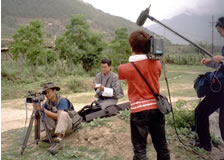 •Production
(May ï October) •Production
(May ï October)
A prolonged winter worried both the teacher and myself. To
reach Lunana one had to make four passes over 4500 meters
above sea level. One actually standing at 5200 meters. In
the beginning of May the weather report from Lunana was not
encoyraging. None of the passes were open. Instead it was
still snowing heavily in two of the passes.
Filming in Thimphu began in May where six scenes were shot.
We also conducted a religious ceremony for the success of
the production and for the well-being of the all involved
production crew, support staff and even horses and yaks that
will join us from Tashithang and Laya.
The journey to Lunana began on 17th May as foretold by the
astrologer. We filmed the teacher as he left Thimphu for Punakha
and Tashithang on truck with his belonging.
The long trek kicks off in Tashithang and till Gasa we had
no problem except for the rain, leeches and sand flies that
have sucked half of my blood from my body. We bid goodbye
to the NHK team who followed us till Tashithang. As the leader
of the expedition I was obviously felt a huge responsibility
coming on my shoulder. Not so much on the success of the film
as much as on the safety of my crew considering the danger
we were venturing into. But we had faith in ourselves and
above all in the almighty.
Nawang submitted his acceptance of the assignment to the Governor
of Gasa who asked us to wait for news from Lunana before we
proceeded any further. The governor being a friend of mine
was worried about our safety. But even after three days no
news came from Lunana. At that point Nawang decided to proceed
to Laya and hope that by the time we get to the foot of the
mountains the passes would clear. We were already running
two days behind schedule. We nevertheless performed a religious
ceremony to the guardian deity of Gasa region – Guru
Gomo. |
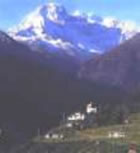 We
left Gasa for Laya on 23rd May. An incessant rainfall accompanied
us making the filming more difficult. We reached Laya where
few more scenes had to be done. News finally came from Lunana
that the passes were through. Rain kept showering on us but
by then we got used to working in wet condition.
We arrived in Lunana on 4rd June – 18 days after we
left Thimphu. The weather in Lunana was much better and except
for occasional showers we experienced a good weather. We had
three weeks of filming instead of two as Nawang encountered
another unforeseen problem – no students. But during
my stay in the valley my biggest worry was the return journey
out of Lunana. In fact my worry turned out to be well-founded.
On the second day of the return trek from Lunana to Laya,
we were caught in a snow blizzard. The temperature dropped
to subzero degree. Wind was blowing at hurricane speed slapping
at us hail and snow. There was no place to take refuge. We
were fully drenched and cold. Our yaks with our dry clothing
were far behind. All the team members, except for one, were
stuck with altitude sickness and hypothermia. I saw my blood
retreating from my left arm. It was one of those near-death
experiences that I was always told of. Fortunately everyone
survived but with a shock. Today my little finger bears the
mark of that experience. We arrived back to Thimphu mid July
while my cameraman and soundman continued in Lunana filming
the teacher for the entire scholastic year. I had nevertheless
brought back 60% of the footages required for the film. |
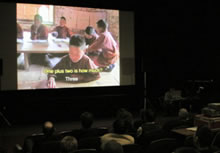 •Post
production & presentation •Post
production & presentation
I started working on the post production in August. The rest
of July was spent catching up with the administrative works
back in the office. I completed the rough editing by the end
of August. Two misfortunes stuck us in the beginning of September.
Camera broke down beyond repair in Lunana and the cameraman,
Sonam Loday had to trek in shortest possible time to Thimphu
and back to Lunana. It was then I felt that I had made the
right choice in Sonam because no ordinary person would do
that. After this was settled, the wife of the soundman, Sherab
met with an accident in Thimphu. So another logistic arrangement
was made to evacuate the soundman. There was also another
human side of the problem. Whether or not I should tell the
soundman what had happened in Thimphu. If I did, he might
rush over to Thimphu and die of altitude sickness. If I don’t
and if his wife dies in Thimphu, I would be blamed. I gathered
the remaining team in Thimphu and we discussed the whole day.
No one could give any suggestion and looked up to me to make
the decision. For a moment we considered helicopter. But then
I met the surgeon who was attending to her who assured me
that she was finally out of danger. We radio-ed to Sherab
to come to Thimphu with the escort but we didn’t tell
him that his wife was in the hospital.
Now the brighter side of the story. Thanks to the Japan Prize,
I was invited to sit in a jury of a ABU TV Award held in Kazakhstan
at the end of September.
Winter came early set in Lunana. Nawang left Lunana at the
end of third week of October. My cameraman followed, filmed
the exit and rushed to Thimphu with the footages. He reached
Thimphu on 22nd October. We worked day and night on the final
post production – in fact till the morning of 26th when
I caught a flight to Tokyo for presentation at Japan Prize
2004. |
•Festivals &
audience response
Thanks to the Japan Prize, School Among Glaciers was selected
without going through the pre-selection process in two film
festivals – Himalayan Film Festival Amsterdam and Basel
Karlsruhe Switzerland. I have received several invitations
to enter the film in other film festivals around the world.
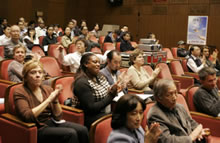 School
Among Glaciers was telecast over BBS on January 1st and 2nd
2005 receiving comments on the online version of Kuensel,
the national newspaper.
A session was dedicated for screening and discussion at the
UNESCO Education for All Workshop on 31st January 2005 in
Kuala Lumpur. Subsequently UNESCO screened the film at EFA
Workshop for the Journalists from ten-most populous States,
New Delhi, February 4, 2005.
•Concluding words
In Bhutan, School Among Glaciers has provoked a serious discussion
on issues raised by the film. Both the Minister and the Secretary
of Education complimented me for the film. I was personally
praised by the minister who gave me the carte blanc to raise
any issue on education in the country. No producer in Bhutan
has been accorded this privilege.
The Ministry of Education plans to screen the film at the
Annual Education Conference 2005. |
•Acknowledgement
In Bhutanese there is a phrase that describes the coming together
of all good things in life phunsum tsho ni. I consider School
Among Glaciers one of such event where all good things came
together. The award in Japan followed by unconditional support
from UNICEF and WFP who supplemented the production budget,
Deutsche Welle who provided the crash course, private companies
who sent contribution in kind, teacher who never faced a camera
in his life but turned out to be a great actor, people and
students of Lunana who had never seen a camera and Japan Prize
who invited me to premiere it in Japan.
Above all, I pay my homage and gratitude to the Japan Prize
and Hoso Bunka Foundation who have initiated the award to
promote good ideas that would otherwise remain shelved forever.
Dorji Wangchuk Thimphu 1.3.2005
|
|